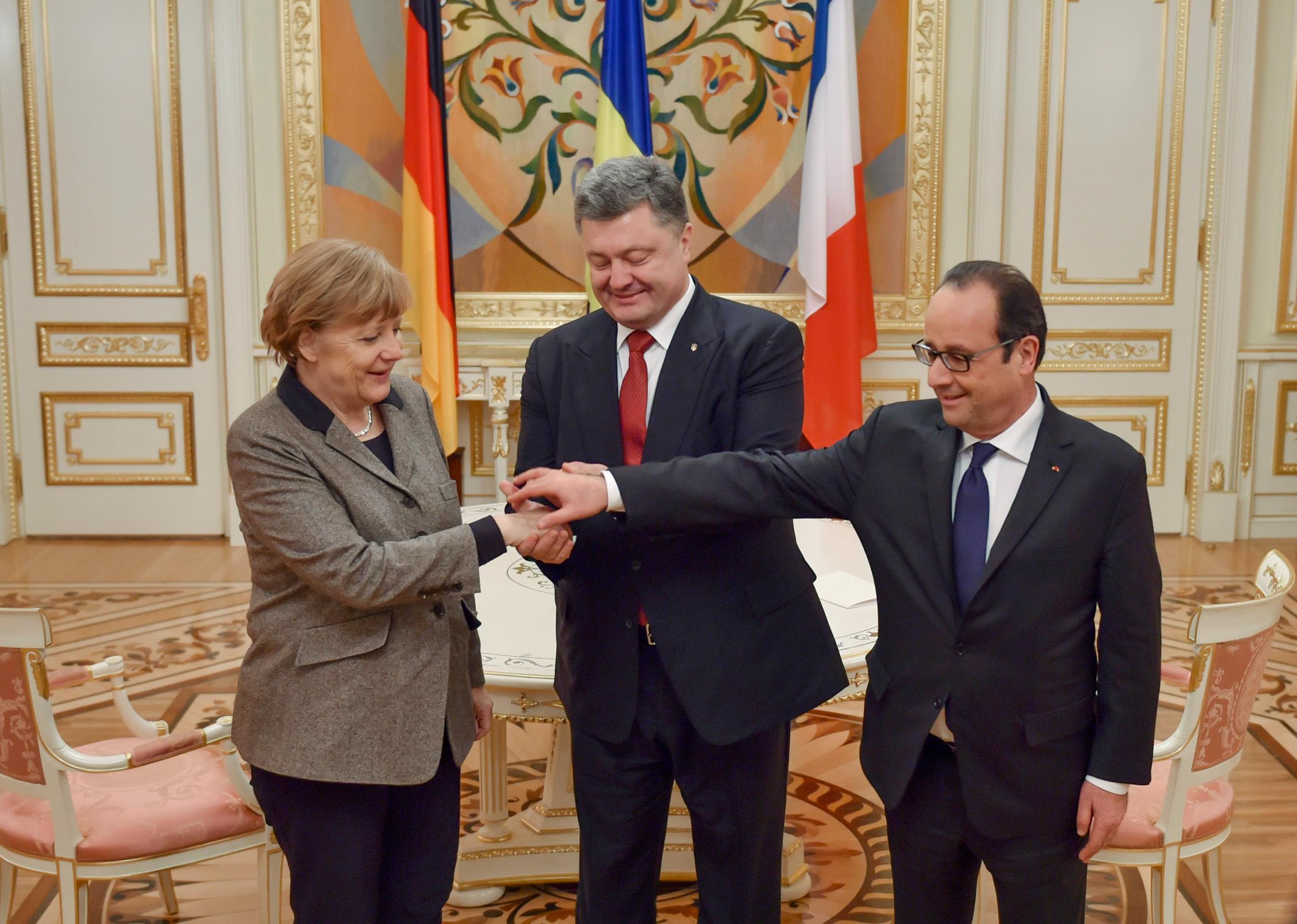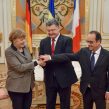
Angela Merkel, Francois Hollande Attempt to Mediate Between Russia and Ukraine
Publication: Eurasia Daily Monitor Volume: 12 Issue: 24
By:

German Chancellor Angela Merkel and French President Francois Hollande conferred during the night of February 5–6 with Ukrainian President Petro Poroshenko in Kyiv. The three leaders and their advisory teams discussed a proposal from Russian President Vladimir Putin for an armistice in Ukraine, and a German-French counter-proposal. Merkel and Hollande proceeded on February 6 to Moscow. The Russian president had initiated this process in secrecy during the preceding week.
At the same time, US Secretary of State John Kerry conferred with the Ukrainian leaders in Kyiv on Feburary 5. His pre-scheduled visit overlapped with the Merkel-Hollande impromptu visit to the Ukrainian capital. The two sets of talks were held along separate tracks. Speaking to reporters at his own press briefing, Kerry said he was made privy to the Merkel-Hollande proposal destined for Putin. But the Secretary of State made clear that he had no part in that process and merely conceded the lead to Berlin and Paris (rather than the European Union). Both Kerry in Kyiv and (on the same day) Vice President Joseph Biden in Washington conclusively ruled out the provision of defensive arms to Ukraine (see below).
Merkel and Hollande had given no advance notice of their visit, made no contact with the media in Kyiv, and declined to issue a joint written statement with Poroshenko. However, fragmentary remarks by German and French officials to the press in the respective capitals (Le Figaro, France Inter, Sueddeutsche Zeitung, Die Welt, EurActiv, February 5; Ukrinform, February 5, 6) seem to hint at some elements of a package proposal that was apparently presented to Putin in Moscow on December 6:
– An immediate, “bilateral” ceasefire, before any further issues are tackled (the term “bilateral” may seem self-understood or redundant in a ceasefire, but is reassuring to Ukraine, which experienced a unilateral ceasefire being imposed on it by Berlin and Moscow in June 2014);
– Putin to use his influence on the “separatists” to stop hostilities and bring them back to negotiations with Kyiv (which the Donetsk and Luhansk “people’s republics” had broken on January 31—see EDM, February 4, 5);
– The demarcation line, defined in the September 2014 Minsk armistice agreement, to be replaced by a new, “Minsk Plus” line, reflecting the “separatists’ ” recent military advances.
– A special status to be worked out for the Russian-controlled territory in Ukraine’s Donetsk and Luhansk provinces;
– Kyiv to contribute economic sustenance to that territory outside its control;
– Ukraine to preserve its legal sovereign title to that territory;
– An ultimate political resolution to be negotiated, acceptable to all parties involved (this qualification would imply Russian and secessionist blocking power, on the classical “frozen conflict” model);
– No provision of arms to Ukraine;
– Some sort of assurances that Ukraine remains a neutral country (i.e., stays out of the North Atlantic Treaty Organization—NATO).
This package presumably also contains ideas regarding the disengagement of forces, border control, and economic relations between Kyiv and the Russian-controlled territories. A protracted negotiation process is anticipated, once a ceasefire is in place.
Those elements imply re-negotiating the terms of September 2014 Minsk armistice agreements. Ukrainian officials unanimously insist that Kyiv would never renounce the safeguards contained in those agreements (Dzerkalo Tyzhnia [Zerkalo Nedeli], February 6). The Merkel and Hollande delegations agreed, while in Kyiv, that those agreements remain “the main basis” for further negotiations. Renegotiation would be presented as a road map toward implementation of the original armistice, but this could hardly disguise new conditions and time-frames being imposed by Russian power on the ground. Ukrainian Prime Minister Arseniy Yatsenyuk told the media that signing a new armistice agreement without the implementation of the existing agreement “could lead into a trap” (Kmu.gov.ua, February 5).
Merkel and Hollande each said that their joint initiative was meant to represent overall European interests. However, France only adds a thin European veneer to actual German leadership. The European Union as such has neither mandated nor contributed to this initiative. The EU’s high representative for foreign and security policy, Federica Mogherini (former Italian foreign minister), and the European Council president, Donald Tusk (former Polish prime minister), differ with each other over Russia, Ukraine and other issues.
As Yatsenyuk noted, the various formats that have been tested (German-French, German-French-Russian, “Normandy,” Geneva format) are all inadequate because they disperse the main Euro-Atlantic forces. The United States, European Union, Germany in its own right, and Ukraine should all “sit at the negotiation table together, with a common and firm position.” Yatsenyuk further pointed out that Ukraine needs defensive weapons to stop and deter Russian advances. He made these remarks while meeting with Kerry, whose government has withdrawn from the negotiating format and has withheld defensive weapons from Ukraine (Kmu.gov.ua, February 5).
In his Kyiv press briefing on February 5, Kerry counseled Ukraine that “the best defensive weapons are reforms,” and left it at that. On the same day, Vice President Joseph Biden ruled out arms supplies to Ukraine with equal finality, in a syndicated interview for the European press. Non-lethal equipment only, Biden said (Le Monde, Gazeta Wyborcza, February 5).




